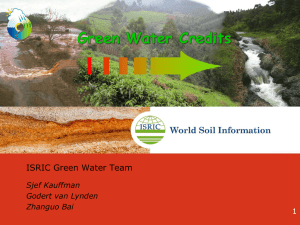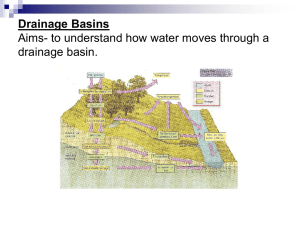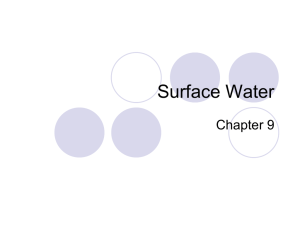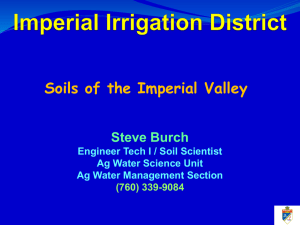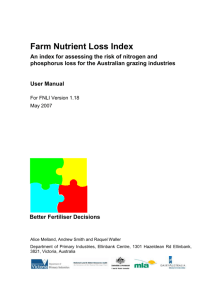FNLI Paddock Record Sheet
advertisement
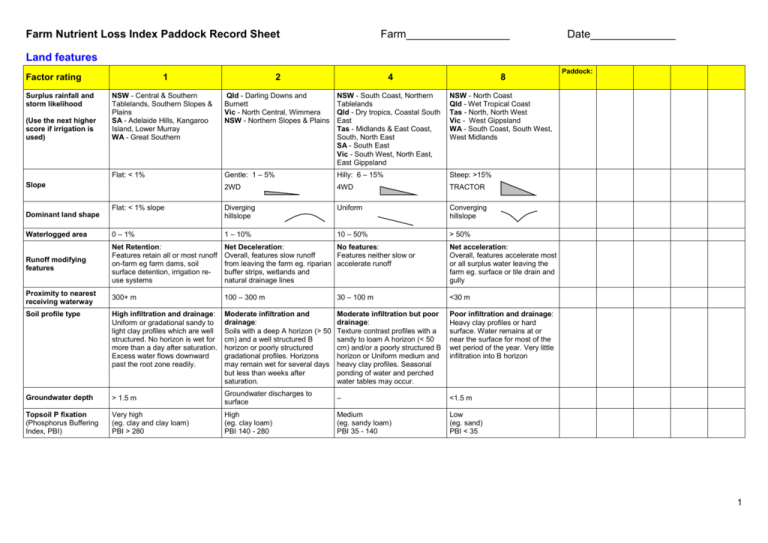
Farm Nutrient Loss Index Paddock Record Sheet Farm_________________ Date______________ Land features Factor rating 2 4 NSW - Central & Southern Tablelands, Southern Slopes & Plains SA - Adelaide Hills, Kangaroo Island, Lower Murray WA - Great Southern Qld - Darling Downs and Burnett Vic - North Central, Wimmera NSW - Northern Slopes & Plains NSW - South Coast, Northern Tablelands Qld - Dry tropics, Coastal South East Tas - Midlands & East Coast, South, North East SA - South East Vic - South West, North East, East Gippsland NSW - North Coast Qld - Wet Tropical Coast Tas - North, North West Vic - West Gippsland WA - South Coast, South West, West Midlands Flat: < 1% Gentle: 1 – 5% Hilly: 6 – 15% Steep: >15% 2WD 4WD TRACTOR Flat: < 1% slope Diverging hillslope Uniform Converging hillslope Waterlogged area 0 – 1% 1 – 10% 10 – 50% > 50% Runoff modifying features Net Retention: Features retain all or most runoff on-farm eg farm dams, soil surface detention, irrigation reuse systems Net Deceleration: No features: Overall, features slow runoff Features neither slow or from leaving the farm eg. riparian accelerate runoff buffer strips, wetlands and natural drainage lines Net acceleration: Overall, features accelerate most or all surplus water leaving the farm eg. surface or tile drain and gully Proximity to nearest receiving waterway 300+ m 100 – 300 m 30 – 100 m <30 m Soil profile type High infiltration and drainage: Uniform or gradational sandy to light clay profiles which are well structured. No horizon is wet for more than a day after saturation. Excess water flows downward past the root zone readily. Moderate infiltration and drainage: Soils with a deep A horizon (> 50 cm) and a well structured B horizon or poorly structured gradational profiles. Horizons may remain wet for several days but less than weeks after saturation. Moderate infiltration but poor drainage: Texture contrast profiles with a sandy to loam A horizon (< 50 cm) and/or a poorly structured B horizon or Uniform medium and heavy clay profiles. Seasonal ponding of water and perched water tables may occur. Poor infiltration and drainage: Heavy clay profiles or hard surface. Water remains at or near the surface for most of the wet period of the year. Very little infiltration into B horizon Groundwater depth > 1.5 m Groundwater discharges to surface – <1.5 m Topsoil P fixation (Phosphorus Buffering Index, PBI) Very high (eg. clay and clay loam) PBI > 280 High (eg. clay loam) PBI 140 - 280 Medium (eg. sandy loam) PBI 35 - 140 Low (eg. sand) PBI < 35 Surplus rainfall and storm likelihood (Use the next higher score if irrigation is used) 1 Slope Dominant land shape 8 Paddock: 1 Nutrient management Factor rating 1 2 4 8 Soil P test (mg/kg) Low soil P Medium soil P High soil P Very high soil P Olsen P 0-10 cm 0-7.5 cm <7 <9 7 - 15 9 - 19 16 - 25 20 - 30 >25 >30 Colwell P (10cm) light soils medium soils heavy soils <6 <12 <18 6-18 12-35 18-50 18-30 35-60 50-90 >30 >60 >90 Fertiliser P rate (kg P/ha) None or <11 kg/ha annually 11-25 kg/ha annually 25-59 kg/ha annually > 60 kg/ha annually; single dose and/or no soil test, nutrient budget Fertiliser N rate (kg N/ha) 0 to <30 per application < 100 annually 30 - 60 per application 100 -250 annually 30 - 60 per application >250 annually > 60 per application and/or> 250 annually Nutrient hotspots (% area of paddock) Low: < 5% Medium: 5 - 10% High: 10 - 20% Very high: > 20% Apply when very low runoff or drainage risk: Apply when low runoff or drainage risk: Apply when moderate runoff or drainage risk: Apply when high runoff or drainage risk: Apply P when soil is dry and storm event is not forecast within 4 days. If N is used, apply during active pasture growth when soil is moist, but not waterlogged, except 2 days before or after storm rain or irrigation. More than 28 days between N applications. Apply P when soil is dry and storm event is not forecast within 4 days. Apply N during active pasture growth at any time of year, except 2 days before or after storm rain or irrigation. More than 28 days between N applications. Apply P when soil is dry or moist, but not waterlogged, and storm event is not forecast within 4 days. Apply N more than 3 times per year at any time, except 2 days before or after storm rain. N might be applied to water-logged soil or before irrigation. More than 28 days between N applications. No effluent applied Applications match pasture needs. Effluent quality tested. Low rate regardless of pasture needs: < 25 mm/ha per application, irrespective of soil condition or plant needs. Summer or autumn surface application or incorporation. Backup recycle dam used to capture excess effluent. Spring application when no Effluent applied when soils heavy rain forecast for 7 days. already waterlogged or heavy 'Short watering' used to eliminate rain expected in <7 days. runoff from flood irrigation. Effluent applied to land during winter and/or no effluent storage system and/or effluent drains directly off-farm. ≤ 1.5 milking cow/ha Less than 1 beef cattle/ha 8 DSE/ha or less 1.5-2.5 milking cow/ha 1-1.5 beef cattle/ha 9-13 DSE/ha 2.5-3.5 milking cows/ha 1.5-26 beef cattle/ha 14-24 DSE/ha 3.5 milking cows/ha or more 2 beef cattle/ha 25 DSE/ha or more Lucerne eg >30% lucerne Deep rooted perennials eg >30% phalaris, kikuyu or native red grass. Shallow rooted perennials eg >30% perennial ryegrass, white clover, cocksfoot or wallaby grass. Annual species such as grasses and sub clover, eg < 30% perennial species 70 - 80 % 50 - 70 % < 50 % Timing of fertiliser application Effluent rate Effluent timing Paddock: Apply P or N at any time of year regardless of heavy rain forecast and/or less than 28 days between N applications. Effluent not tested and/or applied at high rate: >25 mm/ha, irrespective of soil condition or plant needs. Pasture management Stocking rate Pasture type Ground cover - lowest >80 % level during the year 2
